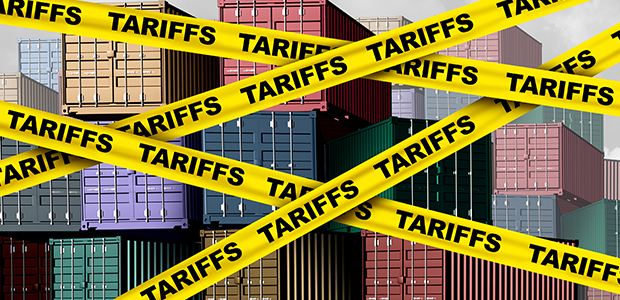
Wood Mackenzie Report Examines Three Tariff Scenarios
A new report from Wood Mackenzie puts tariffs’ impact into numbers by looking at three scenarios. In the firm’s most optimistic scenario, in which a truce reverts tariffs to 2024 levels, stronger economic growth helps increase oil demand by 4.4 million barrels a day from 2024 to 2030.
But if trade tensions persist and the United States’ effective tariff rate jumps from 2.3% in 2024 to 10% from 2026-2030, demand will grow at a slower pace, Wood Mackenzie finds. “Global demand still rises by 3.5 million bbl/d by 2030, almost 1 million bbbl/d less than in the trade truce scenario,” the firm clarifies. “Slower demand growth means lower prices: Brent averages $68/bbl in 2030 in real terms, $6 less than in the trade truce scenario.
“Lower prices curtail drilling and completion activity in the U.S. lower 48, reducing a key source of non-OPEC supply growth,” Wood Mackenzie adds.
As of late May, Wood Mackenzie calls the 10% trade tension scenario the most likely. However, the firm also evaluated a more severe alternative.
“Under our trade-war scenario, the U.S. implements the tariffs announced on April 2 in full, with trading partners retaliating. The U.S. effective tariff rate quickly exceeds 30%,” Wood Mackenzie describes. “This causes maximal supply chain disruption, including U.S.-China decoupling, triggering a global recession. In this scenario, global GDP is 2.9% lower by 2030.”
Such a recession would cause oil consumption to shrink in 2026, Wood Mackenzie says. “Demand growth resumes from 2027, but overall demand by 2030 is still 2.5 million bbl/d lower than under the trade truce scenario,” the firm assesses.
“Weaker demand leads to a plunge in prices as supply significantly surpasses global demand. We project Brent crude to average $50/bbl in 2026, recovering somewhat after 2026 as the price shock helps stabilize the supply and demand balance,” Wood Mackenzie continues. “Oil prices are still expected to be weak by the end of the decade in this scenario, with Brent projected to average $63/bbl in real terms in 2030. That is $11/bbl lower than under the trade truce scenario.”
The firm says a full trade war would also reduce investment, leading to lower U.S. oil production through 2030 despite the industry’s ongoing efficiency gains. “Supply growth outside the United States would also be affected by low prices due to reduced budgets for upstream projects, with delays expected in projects not yet under development,” Wood Mackenzie predicts.
Natural Gas and LNG
The trade war scenario would hurt LNG demand. “Sluggish demand in Asia means more excess LNG supply is absorbed in Europe, where economic stagnation limits gas use,” Wood Mackenzie says.
U.S. LNG exporters would face tight margins, Wood Mackenzie continues. However, “U.S. gas prices remain resilient in this scenario, despite a downturn in the economy, as falling oil prices reduce U.S. associated gas production, requiring the production of additional higher-breakeven dry gas.”
Wood Mackenzie says at the other end of the spectrum, if trade barriers return to 2024 levels, the global LNG market will remain tight this year despite weak demand in Asia. “Europe needs to rebuild storage after a cold winter, while facing the loss of further Russian supply following the end of the Ukraine transit agreement,” the firm explains.
But according to the firm, that tightness will be temporary. “The anticipated oversupply emerging from 2027 remains inevitable, even if tariffs are removed. With a major expansion of LNG supply already under construction and more supply expected to reach final investment decision in the coming years, LNG supply is set to increase by more than 40% higher than current levels,” Wood Mackenzie says.
Growing demand from Asia will use some of that supply, but Europe “will need to absorb more LNG than required, pushing average prices down from $11.2/mmbtu in 2024 to around $7.2/mmbtu by 2030.”
In the United States, LNG export growth and data centers will almost double Henry Hub prices, with Wood Mackenzie projecting they will rise from $2.4/mmbtu in 2024 to more than $4.5/mmbtu by 2030.
In the more likely trade tensions scenario, tariffs still have some impact on LNG prices, though not as much as they do on oil prices. “Weaker trade flows and economic growth slows gas demand growth in Asia compared with the trade truce scenario, accelerating the rebalancing of the global LNG market at lower prices,” Wood Mackenzie outlines.
However, “we would not expect these effects to be very large, given inelastic heating demand and continued growth in industrial production. We project gas demand to be about 10 billion cubic meters (7.2 million tons) per year lower across Europe and Asia than under the trade truce scenario. This results in modestly weaker LNG prices, reaching $6.9/mmbtu by 2030.
“In the United States, the trade tensions scenario does little to derail LNG growth, keeping Henry Hub prices high,” Wood Mackenzie predicts.
The full report also looks at the trade truce, trade tension and trade war scenarios’ impact on refining margins, electricity demand and metals. To read it, visit Trading Cases: Tariff Scenarios for Taxing Times.
For other great articles about exploration, drilling, completions and production, subscribe to The American Oil & Gas Reporter and bookmark www.aogr.com.






